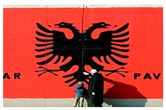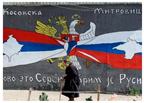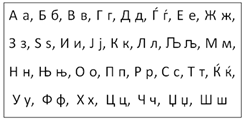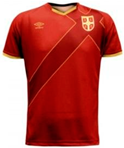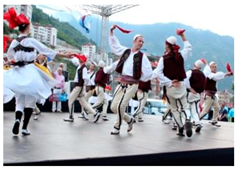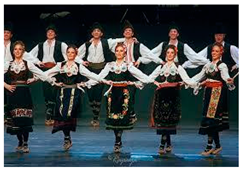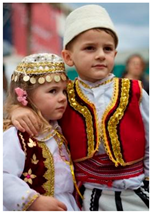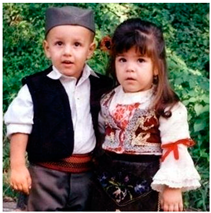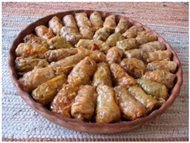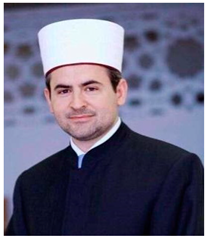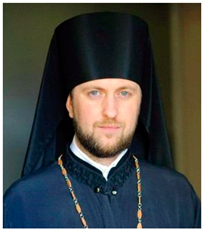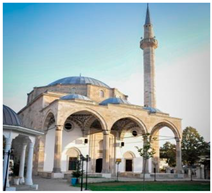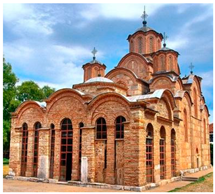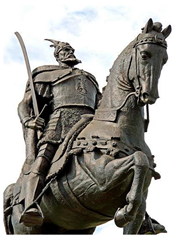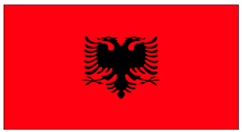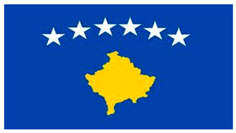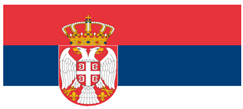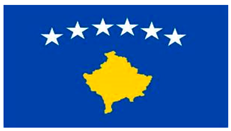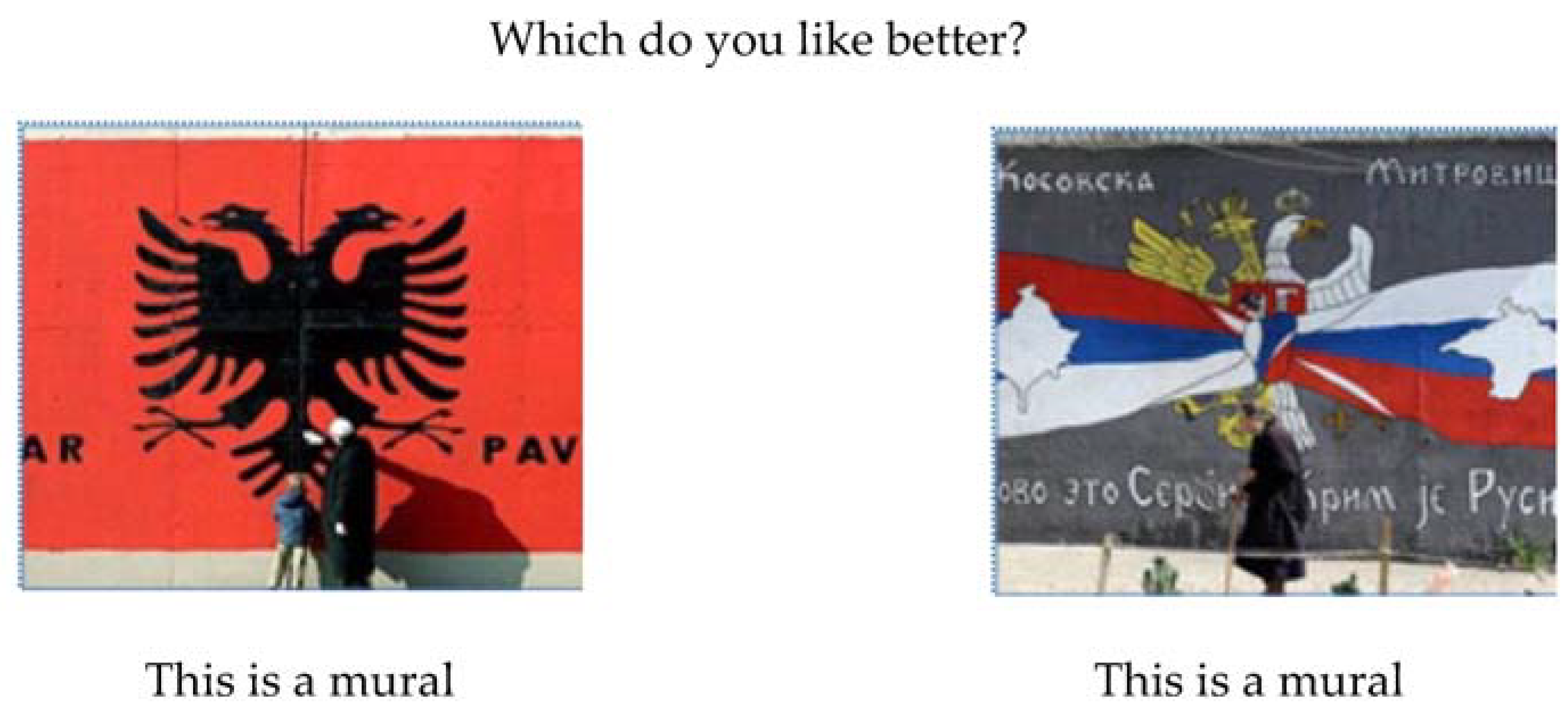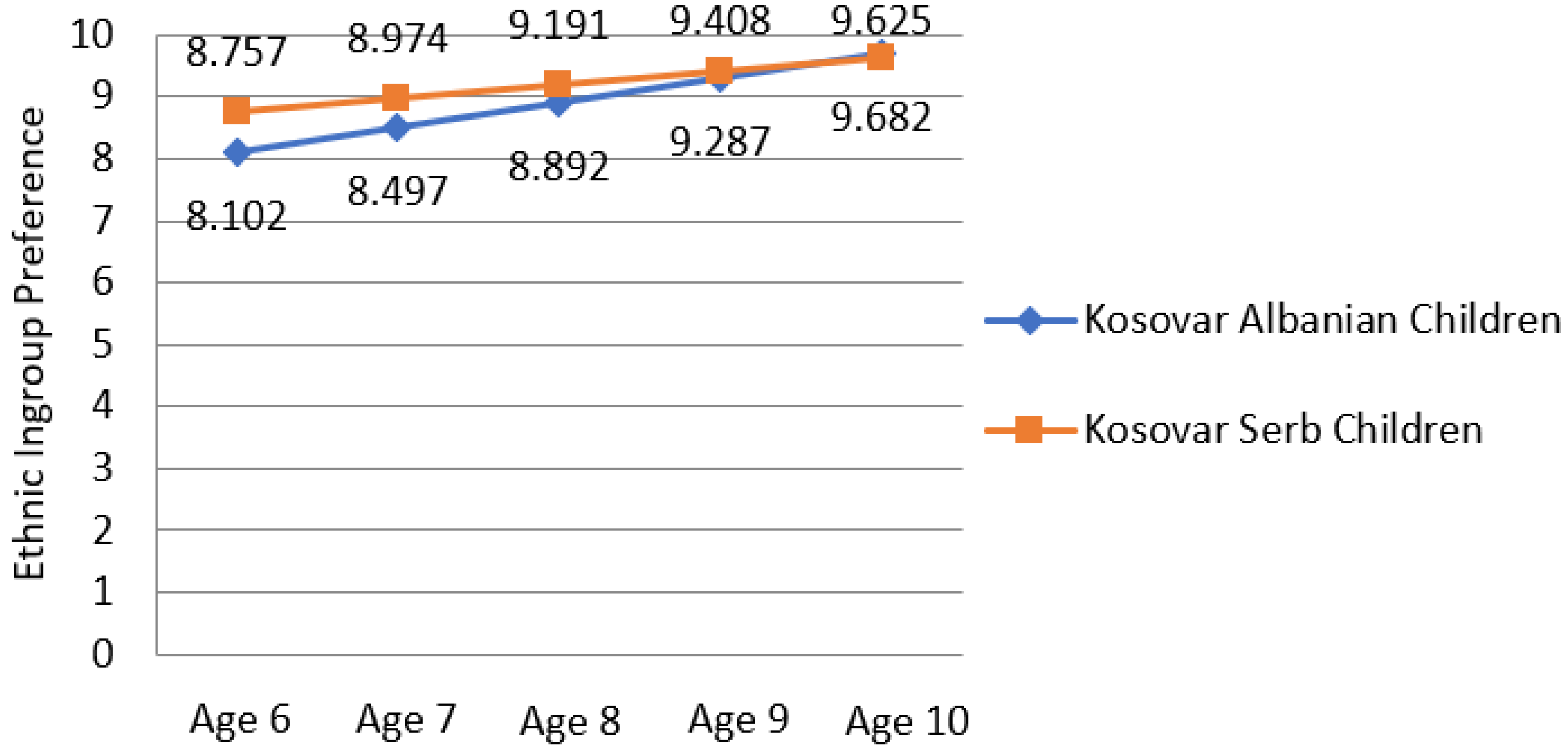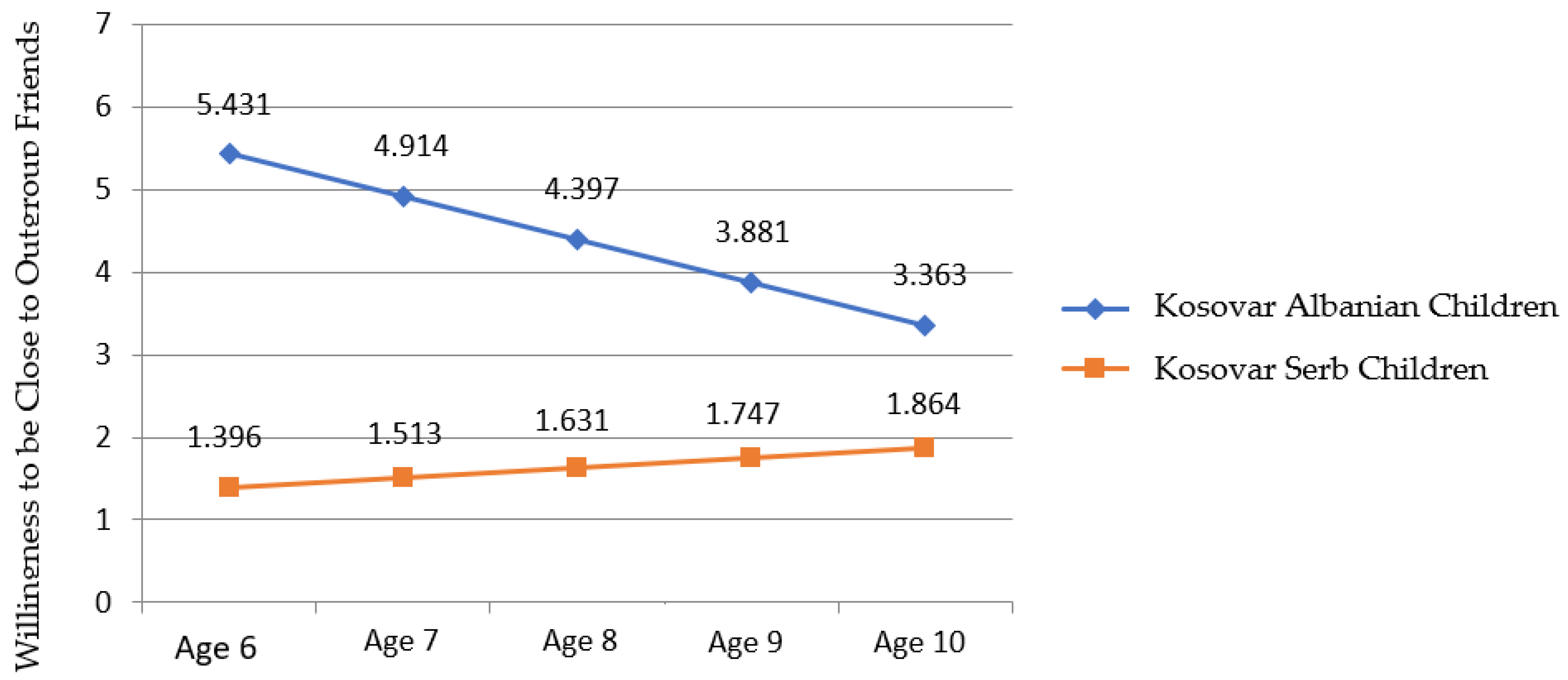1. Introduction
Childhood is a significant period during which children develop their sense of group identity. This period lays the foundations for understanding which groups a child belongs to and the norms that come with these group memberships. A growing body of evidence outlines how children acquire knowledge about groups, how they join groups, and how involvement with groups shapes their attitudes (e.g.,
Aboud 1988;
Nesdale 1999,
2004,
2007). Yet, research and theory on the development of, and preferences for, social groups among children is far more limited compared to research on adults (
Nesdale 2017). The majority of studies conducted so far come from multicultural contexts such as the United States and Australia, while a big gap remains in testing identity developmental models among children in divided societies with a history of conflict (
Griffiths and Nesdale 2006; for exceptions see
Taylor et al. 2020,
2021;
Tomovska-Misoska et al. 2020). Informed by the Social Identity Development Theory (SIDT;
Nesdale 1999,
2004), this paper explores how group preferences develop among children living in the post-conflict context of Kosovo and how this development shapes children’s willingness to be close to their outgroup peers among the segregated majority (ethnic Albanian) and minority (ethnic Serb) members.
1.1. Social Categorization and Intergroup Attitudes among Children
Previous work shows that children’s ability to recognize group differences starts very early on (e.g.,
Aboud 1988). Starting from preschool (i.e., three years of age), children are able to notice visible cues—such as race or gender—and differentiate between themselves and others (
Aboud 1988). They can categorize group symbols such as flags or colors related to ethnic and cultural groups even before they are able to understand what the symbols actually mean (
Connolly et al. 2009;
Dautel et al. 2020). By the age of five to six, children show preferences for social groups, as they start to identify with ethnic or national groups. By ten or eleven years old, they can describe their own and other groups in terms of clothing, traditions, language, or physical characteristics that describe them (e.g., ethnic and cultural symbols between Catholics and Protestants in Northern Ireland, see
Connolly et al. 2002; for national groups, see
Barret 1996,
2001).
When children begin to identify with relevant groups (i.e., between 5 to 6 years old), they may also begin to express negative attitudes and prejudice towards members of the outgroup (e.g., “they’re Protestants, they’re bad because they wanted to kill us”, Catholic boy, age 6; in
Connolly et al. 2002;
Raabe and Beelmann 2011). However, whether or not children show negative evaluations and prejudice towards outgroups may depend on an important contextual variable: contact experiences with members of the outgroup. A meta-analytic study covering 113 studies with children across different ethnic, national and racial backgrounds showed that prejudice (i.e., including constructs such as prejudice, attitudes, stereotypes, ingroup bias, intergroup attitudes or preferences) towards members of the outgroup has different developmental trends for children of majority and minority groups and the contexts in which they grow up in—that is, whether they have intergroup contact or not (
Raabe and Beelmann 2011). Children of majority (high status) groups report significantly more negative evaluations of their peers before they start school (2–4 years old) because they have less opportunities to interact with their minority peers. However, prejudice decreases during subsequent phases of development (5–7 and 8–10 years of age) if children from majority groups are exposed to contact experiences (
Raabe and Beelmann 2011). The effects of contact are significant even in cases where children have only a few contact experiences with minority peers (i.e., when the proportion of outgroup members at school or the region was as little as 5%;
Raabe and Beelmann 2011). Children of minority (low status) groups on the other hand report significantly more negative evaluations for their peers from the majority groups when they start school (i.e., negativity increases between 5–7 years), possibly because of implicit or explicit prejudice and discrimination that minority children might experience once they enter school (
Banaji et al. 2008;
Verkuyten 2002). The trend among minority children remains at similar levels in the following years and is not moderated by the extent of contact they have with their peers from majority groups. The positive effects of contact in shaping intergroup attitudes, especially for children of majority groups, are in line with findings among adults showing similar favorability in attitudes among majority members stemming from intergroup contact (see
Pettigrew and Tropp 2006,
2008; for meta-analyses on contact among adults).
That context matters for the development of intergroup relations and has also been validated by research conducted particularly in divided societies similar to Kosovo—the setting examined in this study. For instance, previous work with Jewish and Arab groups in Israel showed that negative attitudes towards outgroups are more likely in contexts in which ingroup–outgroup differentiations are readily salient and where conflict narratives are maintained by the communities (e.g., schools, see
Bar-Tal and Teichman 2005;
Bar-Tal et al. 2017). When children live in divided communities that are overwhelmingly reflective of a particular ethos, such as exposure to flags or murals signifying particular communities, it may impact their attitudes as well as their emerging identities (e.g., see
Connolly et al. 2002,
2009; for Protestant and Catholic communities in Northern Ireland).
A recent approach that has been accumulating growing support for explaining these intra and inter-group related processes among children is Social Identity Development Theory (SIDT,
Nesdale 2004,
2007). Building on principles of the social identity approach (Social Identity Theory,
Tajfel and Turner 1979,
1986; Social Categorization Theory,
Turner et al. 1987), and modifying them to apply to children, SIDT outlines a developmental process by which children move from becoming aware about social groups to potentially showing prejudice towards outgroups (
Nesdale 1999). SIDT proposes that children from birth to 12 years of age move through four sequential phases of development: foundations of social group relations (i.e., when children begin to engage in social interactions although social groups have no meaning yet), social group awareness (i.e., they begin to categorize themselves and others into socially relevant groups), social group preference (i.e., show a focus on and a preference for their ingroups), and out-group negativity (i.e., emerging prejudicial attitudes which can crystalize further if the context fosters that;
Nesdale 2017). The theory argues that while most children may never really develop outgroup negativity, those who identify strongly and those exposed to group norms that endorse out-group prejudice are more likely to do so (see
Nesdale 2017 for the latest overview of SIDT). Given that previous work has shown that adults in Kosovo strongly identify with ethnicity and hold very negative inter-ethnic evaluations of one-another (i.e., feel very cold towards ethnic outgroup members and have negative stereotypes;
Maloku et al. 2016) we reasoned that this context may be a fertile ground for the development of negative attitudes among children as well. It is in Kosovo’s context that we explore how group preferences and outgroup attitudes develop among children.
1.2. Division in the Kosovo Context and Rationale for the Study
Kosovo is a small landlocked territory that was the last to endure a conflict related to the Yugoslav breakdown in 1998–1999, following the wars of Croatia and Bosnia and Herzegovina in the early 1990s (
Malcolm 1998). Its history reflects decades of diverging aspirations between the ethnic Albanian majority (about 87%) seeking independence from Serbia and the ethnic Serb minority (about 8%) wanting to remain connected to Serbia (
European Centre for Minority Issues Kosovo 2013;
Judah 2008)
1. The differences between the two ethnic groups further widened when Kosovo declared independence in 2008, following an international military intervention and a United Nations peacekeeping mission overseeing Kosovo for over a decade. The conflict left over 13,000 victims, of which over 10% were children, and its effects linger even today as the groups remain divided along ethnic lines (
Prishtina Insight 2019). The division looms larger among children as they attend ethnically separated schools and education systems that do not collaborate. Specifically, ethnic Serbs follow a Serbian state education system that runs parallel to the Kosovo state run education that is followed by ethnic Albanians. As a result, children of these two particular ethnic groups are not exposed to peers from the ethnic outgroup being investigated here. The new generations of Kosovar citizens are no longer able to speak each other’s languages because schools have removed the outgroup language from their curricula since the early 1990s. The language barrier between ethnic groups remains then despite both Albanian and Serbian being official languages in Kosovo today.
These burdened intergroup relations reflect the broader social context in which Kosovar Albanians and Kosovar Serbs live. Since the conflict ended, members of the Kosovar Serb minority have predominantly settled in segregated ‘pocket regions’ throughout the country, especially in the north that is adjacent to Serbia. Although Kosovar Serbs have broad political and institutional representation that is guaranteed at the local or central level, opportunities for contact with Albanian majority outside of these settings remain limited. Ethnic identity is often used for political reasons, thereby hindering attempts for integration.
Unlike other countries that broke away from Yugoslavia, Kosovo’s independence initiated the formation of a new national identity—the Kosovar identity. Among others, the new Kosovar state gained its own flag, designed to represent all ethnic groups living in the country. The flag has a map of Kosovo in the centre and six overarching stars, each star representing the country’s major ethnic groups (majority ethnic Albanians, and minority ethnic Serbs, as well as other ethnic minorities like Turkish, Bosniaks, Gorani, Romani—often grouped together with Ashkali and Egyptian ethnic groups). The blue background of the flag conveys the European perspective to which the country aspires.
However, more than a decade has passed since independence and the different ethnic groups show different preferences towards the new Kosovar identity, especially in terms of how it co-exists with their ethnic subgroup identity (see
Maloku et al. 2016 for an overview of ethnic and national identification in Kosovo). A recent study among adults in this context showed that the Albanian ethnic majority perceives the Kosovar identity as an extension of their own ethnic identity, while it is a non-identity for the Serb minority who feel that the Kosovar identity is not inclusive of them (
Maloku et al. 2019). The two ethnic groups have minimal inter-ethnic contact and show reluctance to be each-other’s neighbors (
Maloku et al. 2019;
Maloku 2019). These limited opportunities for intergroup contact may hinder the development of more inclusive identities among ethnic groups, especially among ethnic majority members (
Maloku et al. 2023;
Taylor et al. 2023).
What we do not yet know is whether ethnic and national preferences and intergroup evaluations found among adult samples in Kosovo are mirrored among children. In this correlational study with children, we examine the relationship between preferences for ethnic and national symbols that signify ethnic and national identities (i.e., flags and neighborhoods, traditions and religion, sports, and music), as well as the willingness of Kosovar Albanian and Kosovar Serb children to be close to their outgroup peers. In doing so, we also explore the underlying process by which these preferences and attitudes develop. These insights that we gain from children (6–10 years old) who were socialized after the country’s independence are particularly interesting to study as these generations may hold the potential to be the peacebuilders of the newest European nation—or to continue the conflict of their ancestors.
1.3. Ingroup Preferences
The majority of studies investigating ingroup preferences have commonly been comparative in nature, e.g., they presented children with a doll or photographs of various group symbols and markers and asked them to indicate which ones they liked more or considered to have better qualities (
Connolly et al. 2002,
2009;
Nesdale et al. 2005a,
2005b). For instance, previous work carried out with children in other divided contexts, such as Northern Ireland, has found that Protestant and Catholic children show clear preferences for their own group symbols like flags, names, and colors that represent ethno-religious groups (
Connolly et al. 2002;
Taylor et al. 2020). Extending this line of work in Northern Ireland and building on our own previous findings with adults showing that Albanians and Serbs in Kosovo strongly identify with their ethnicity (see
Maloku et al. 2016,
2019), we predicted that Kosovar Albanian and Kosovar Serb children will show high ethnic ingroup preferences (H1a).
Given that there is an emerging national (Kosovar) identity that follows the country’s independence (
Maloku et al. 2016), and adults from these two ethnic groups showed different preferences towards that identity in prior research, we also examined the extent to which children prefer the primary symbol by which this superordinate identity is conveyed—the new Kosovo flag (see
Appendix A for details on group symbols used). Building on insights from the Common Ingroup Identity Model among adults (CIIM;
Gaertner and Dovidio 2000), we have already established that members of the Serb ethnic minority in Kosovo feel that the superordinate Kosovar identity is not an identity that includes them, while the Albanian ethnic majority perceives the Kosovar identity as an extension of their Albanian ethnic identity (
Maloku et al. 2016,
2019). We therefore hypothesized that Albanian children would show a higher preference for the new Kosovar flag than Serb children (H1b).
Although children in general show preferences for their ingroups, earlier work in multicultural contexts suggests that ethnic majority children show higher ingroup preferences than minority children (
Griffiths and Nesdale 2006;
Nesdale and Flesser 2001). For instance, a study in Australia found that children aged 5–12 years old from the ethnic majority group (Anglo-Australians) showed higher ingroup preferences compared to members of the ethnic minority (Pacific-Australians;
Griffiths and Nesdale 2006). However, we argue that in Kosovo’s context, this difference in ingroup preference between majority and minority children might be reversed due to the particularities of identity negotiations undergone by the ethnic groups in post-independent Kosovo. That is, the introduction of the new national identity confronts members of these ethnic groups with having to re-evaluate the meaning of their ethnic (subgroup) identities and the new national (superordinate) identity. Past work shows that this identity negotiation comes easier for majority group members (i.e., Kosovar Albanians in our case) who are likely to perceive the national identity as an extension of their old subgroup (ethnic) identity, and one that implicitly reflects their values and group characteristics (i.e., prototypes; see Ingroup Projection Model [IPM],
Mummendey and Wenzel 1999; also see
Devos and Banaji 2005;
Maloku et al. 2016;
Van Leeuwen et al. 2003). For minority group members (i.e., Kosovar Serbs), however, the superordinate Kosovar identity is not reflective of their ethnic group (
Maloku et al. 2019). Identity negotiation therefore motivates minority group members to maintain a positive and distinct ethnic (Serb) identity as a way to reaffirm group boundaries in a context where they are not represented nor included in the superordinate (national) identity by the ethnic Albanian majority (
Maloku et al. 2016; see
Jetten et al. 2004 for distinctiveness threat;
Riek et al. 2006;
Tajfel and Turner 1986). To support this, previous work with adult samples in this context found a high need to maintain positive ethnic distinctiveness among both groups, but this was more pronounced among the Serb minority (
Maloku et al. 2019). Moreover, for adult Serbs, ethnic identification was the strongest form of identification, while for the Albanian majority both ethnic and national (Kosovar) identification was equally strong (
Maloku et al. 2019). The salience of ethnic identity for Serbs in particular might also be a broader reflection of maintaining their ethnic group’s regional position in former Yugoslavia as well (see
Nikolić 2003). For instance, previous work revealed that adult Kosovar Serbs, compared to Kosovar Albanians, identify more strongly with the region of the Balkans where Serbs had a centralized position as an ethnic group (
Maloku et al. 2017). For Kosovar Serbs then, being part of a larger regional context remains salient and may be a tempting source of pride and ingroup strength. We therefore reasoned that the high ingroup preferences shown among adults would also reflect among children in Kosovo. We hypothesized that Kosovar Serb minority children will show higher ethnic ingroup preferences than Kosovar Albanian children (H1c).
Preferences of children for their ingroups have also been found to become stronger as they grow older (
Connolly et al. 2009;
Griffiths and Nesdale 2006;
Taylor et al. 2020). To connect to this past work, we examined whether there are age-related patterns by which Kosovar children learn these group preferences. Given the predicted differences in preferences towards ethnic and national (Kosovar) groups, we hypothesized that Kosovar children from both ethnic groups will show stronger preferences for their ethnic ingroup the older they are (H2a). However, preference for the Kosovo flag—as a symbol of the Kosovar superordinate identity—with age will only be visible among ethnic Albanian children (H2b).
Apart from preferences for ethnic ingroup and national symbols, we also examined whether children’s attitudes towards outgroup peers follow a specific developmental path when they grow up segregated as they do in Kosovo. This resonates with previous work with segregated Albanian and Serb adults in this context, showing that the groups are not only separated but they also want to remain separated (
Maloku et al. 2019). We expected similar intergroup tendencies to occur among children as well, especially since unlike adults, this cohort has an even lower chance to meet people from the other group (e.g., adults might meet at work while children attend schools that are ethnically divided). We thus hypothesized that Kosovar children of both ethnic groups on average will show low willingness to be close to outgroup peers (H3a). Moreover, this reluctance to be close to outgroup peers will increase with age (H3b).
Lastly, SIDT posits that children’s outgroup attitudes are likely to be the most negative when there is an exclusion norm (e.g., having to dislike outgroup children in order to maintain ingroup membership) and groups perceive a threat to ingroup (
Nesdale et al. 2005a). We reasoned that the development of negative outgroup attitudes and group preferences with increasing age might be prompted by the burdened and divided Kosovar intergroup context shown above. As such, children in the Kosovar context might be more likely to move from a mere ingroup preference phase to an outgroup negativity phase as SIDT suggests (
Connolly et al. 2002;
Nesdale 2004,
2017). Given that we expected preference for ethnic ingroup to be stronger with age (see H2a), we also explored whether such ethnic preference among Kosovar children mediates the relationship between age and willingness to engage in contact with outgroup children (H4).
To examine these hypotheses, we used a quantitative instrument that we developed with context-relevant symbols as group markers for Albanian and Serb ethnic groups in Kosovo and the new Kosovar (national) identity. The instrument was built on qualitative work on group preferences in Northern Ireland (
Connolly et al. 2002,
2009;
Taylor et al. 2020;
Tomovska-Misoska et al. 2020). As such, the measure also brings methodological novelty in that it can be adapted for use (for children or adult populations) with these particular ethnic groups in Kosovo or the broader Western Balkans region where the two groups live.
3. Results
Table 1 presents means and standard deviations, while
Table 2 presents bivariate correlations separately per ethnic group. In the following section, we describe results based on the hypotheses we posed.
3.1. What Ingroup Preferences Do Kosovar Children Show?
Children’s preferences for ethnic and national groups mirror previous findings with Albanian and Serb adults in Kosovo that showed high identification with both ethnic (subordinate) and Kosovar (superordinate) identity for ethnic Albanian majority children, but non-identification with the Kosovar identity among ethnic Serb minority children (
Maloku et al. 2019).
In line with the first hypothesis (H1a), results showed that both ethnic Albanian and ethnic Serb children in Kosovo reported very high preferences for their ethnic (subordinate) ingroup (M
ALBANIANS = 8.77, SD = 1.54; M
SERBS = 9.30, SD = 1.15, on a 10-point scale where 10 indicates that all ethnic ingroup images were preferred over outgroup ones, see
Appendix A for details). One-sample t-tests for each ethnic group confirmed that the means were significantly above the theoretical midpoint (5), Albanians: t (118) = 26.68,
p < 0.001, Cohen’s d = 2.44, Serbs: t (100) = 37.43,
p < 0.001, Cohen’s d = 3.73.
As expected (H1b), children showed different preferences for the new Kosovo state flag (compared to their ethnic ingroup flag). A Chi-square test revealed a difference by ethnicity when examining the percentage of children who preferred the Kosovar flag as a symbol of their overarching identity over their ethnic flag (subordinate identity), χ2 (1, N = 220) = 105.824, p < 0.001, with 70% of Kosovar Albanian children preferring the Kosovar flag over their ethnic (Albanian) flag (chosen by 30% of children), while only two percent of Kosovar Serb children reported to prefer the Kosovar flag over their Serb ethnic flag (the latter chosen by the vast majority of them, or 98%).
Crosstab/standardized residual analysis confirmed that Kosovar Albanian children were significantly overrepresented, and Kosovar Serb children significantly under-represented, in their preference for the Kosovar flag from what would one expect on the basis of chance (Albanians: standardized residual = 5.5, Serbs: standardized residual = −5.9, p < 0.001).
In line with the hypothesis (H1c), an independent samples t-test revealed that Kosovar Serb children showed significantly higher ethnic ingroup preferences compared to Kosovar Albanian children, t (218) = 2.81,
p = 0.005, Cohen’s d = 0.38. These results are in line with previous studies with adults in Kosovo, with ethnic Serbs showing higher concerns for maintaining a distinct ethnic identity than ethnic Albanians, possibly as a way to reaffirm group boundaries in a context where ethnic Serbs are a minority (
Maloku et al. 2019; see
Jetten et al. 2004 for distinctiveness threat;
Riek et al. 2006).
Together, the results from H1b and H1c are consistent with the same reasoning: the distinct ethnic (subordinate) identity seems more important for Kosovar Serb children than for Kosovar Albanian ones. This is visible both in the fact that Kosovar Serb children prefer ethnic ingroup over outgroup symbols to a larger extent and are less positive about the symbol representing their overarching national identity (i.e., Kosovar flag) than ethnic Albanian children are.
3.2. When Do Kosovar Children Develop These Ingroup Preferences?
Table 2 shows that there was a positive association between the age of children from both ethnic groups and ethnic ingroup preference (rALBANIANS = 0.034,
p < 0.001; rSERBS = 0.22,
p = 0.03). To examine when Kosovar children develop ethnic ingroup preferences, we ran linear regression analysis with age as a predictor. Given that Serbs reported significantly higher ethnic ingroup preferences, we also added the age-ethnicity interaction term as a predictor in this analysis. In line with Hypothesis 2a, the results revealed that Kosovar children in general show significantly stronger preferences for ethnic ingroup the older they were, β = 0.35, t (217) = 5.05,
p < 0.001, R2 = 11% (also see
Figure 2). Ethnic ingroup preference with increasing age was not moderated by ethnic group as confirmed by a non-significant age-ethnicity interaction term, β = −0.03, t (217) = −1.19,
p = 0.24.
The development of preferences for the new Kosovar flag, however, follows a different trajectory for children of each ethnic group. As predicted (H2b), the relationship between age and preference for the Kosovar flag was positively associated among Albanian children, but no association was found for the Serb children (see
Table 2). Given that, as reported above, only 2% of Kosovar Serb children preferred the Kosovar flag over their Serb ethnic flag, it seems there is a floor effect, and this makes it hard to show a relationship between age and preference for the Kosovar flag for this ethnic group. Follow-up logistic regressions for the Kosovar Albanian sub-sample only revealed that ethnic Albanian children were 1.6 times more likely to prefer the Kosovar flag over their ethnic flag with each increasing year of age, OR = 1.61,
p = 0.005, 95% CI = [1.15, 2.24], Nagelkerke R2 = 0.10.
Taken together, among Albanian children the results on ethnic ingroup preferences and the preferences for the Kosovar flag suggest a similar pattern. That is, for Kosovar Albanian children, preferences for ethnic ingroup and the new national flag are stronger the older children are. For Kosovar Serb children, however, the effect of age is only showable on their ethnic ingroup preference. This combined portion of results on ethnic and national symbol preferences suggests that, for Albanian children, preference for symbols of ethnic ingroup and national identity are aligned, and both become stronger as they age. For Serb children, however, preferences for their ethnic identity increase with age, but this is not related to their preference for the national identity symbol. Even though ethnic and national identities are supposed to be aligned in theory in the new post-independent Kosovo, apparently Serbs do not see their ethnic identity as embedded in the national (Kosovar) identity or may even resist it due to their minority status. The discrepancy between ethnic Serb and ethnic Albanian children is not therefore in the development of their ethnic identity, but in their ability to align their ethnic identity with their national identity, which seems to be more difficult for Serb children.
3.3. Are Children Willing to Be Close to or Contact One-Another and Does This Willingness Change with Age?
Partially supporting the hypothesis (H3a) and replicating previous findings on adult’s willingness to contact outgroup members in Kosovo (e.g.,
Maloku et al. 2016,
2019), we found little willingness to be close to outgroup peers among Kosovar children in general, M
KOSOVAR = 3.24, SD = 2.91, on a scale 0 (no willingness to be close to outgroup children)—7 (high willingness to be close to outgroup children). Almost one-third of children (or 32%) indicated no willingness whatsoever to contact ethnic outgroup children (i.e., responded with a ‘no’ on all forms of the willingness scale). A one-sample t-test for Kosovar children showed that, unlike expected, the mean for willingness to be close to outgroup children was not significantly below the theoretical midpoint (3.5) of the scale, Kosovar children: t (219) = −1.32,
p = 0.19, Cohen’s d = −0.09. However, further unpacking this overall low mean of willingness to communicate with outgroup children revealed specifics of which group causes this difference. That is, an independent samples t-test revealed that, on average, Kosovar Serb children were significantly less willing to be close to Albanian children than vice versa (M
SERBS = 1.69, SD = 2.18; M
ALBANIANS = 4.55, SD = 2.81; t (218) = −8.31,
p < 0.001, Cohen’s d = 1.13; see
Table 1).
Exploring whether the reluctance to be close to outgroup children shown above develops with age (see H3b), linear regression analyses per ethnic group revealed partial support for this hypothesis as well. That is, Kosovar Albanian children (of the range from 6–10 years old) start out being relatively positive towards the Kosovar Serb children but develop more resistance to engage in contact with their Serb peers as they grow up, β = −0.57, t (117) = −2.71,
p = 0.008. The Kosovar Serb children, however, are reluctant to engage in contact with the Albanian children in every age group, β = 0.12, t (99) = 0.62,
p = 0.54.
Figure 3 highlights that a big difference in willingness to be close to outgroup peers is particularly pronounced among six-year-olds. Age explained 24% of variance among Albanian children and 6% among Serb children, respectively. No other significant effects were found.
Overall, the results show that Hypotheses 3a and 3b were partially supported by the data. Namely, the hypothesized low willingness to engage with outgroup members among Kosovar children in general was present only for Kosovar Serbs and remained constant with age, whereas Kosovar Albanian children’s willingness to engage was present among younger children but diminished with age.
In summary, the combined results on group preferences for children in Kosovo and their reported willingness to contact ethnic outgroup peers suggest that while for ethnic Albanian majority children, a preference for national symbols like the Kosovo flag develops with age, the process seems to be reflective of their own identity development only, and not associated with their attitudes towards ethnic Serb children. For the ethnic Serb minority children, a preference for symbols of the overarching identity (i.e., Kosovar) other than their ethnic ingroup symbols remains low regardless of age. Given that preference for the Kosovar flag was not associated with willingness to be close to outgroup peers for any of the ethnic groups, we continued our analyses with ethnic ingroup preferences only.
3.4. Exploring the Underlying Process by Which Willingness to Be Close to Outgroup Children Occurs
The above showed that higher preference for ethnic ingroup symbols was associated with less willingness to be close to outgroup peers, but only among Kosovar Albanian children. The high ethnic ingroup preference found among both ethnic groups—and its negative association with willingness to be close to outgroup peers found only among Kosovar Albanian children—suggests that while ethnic ingroup preference seems to develop with increasing age among children of both ethnic groups in Kosovo, this preference relates to more negative attitudes towards outgroup peers only for the majority (Albanian) children.
To test whether the relationship between age and willingness to be close to outgroup children was mediated by ethnic ingroup preference a mediation analysis was run with Model 4 in the PROCESS (
Hayes 2018) macro for SPSS using bootstrapped mediation with 5000 replications. The analysis was conducted separately for each ethnic group. The model reports unstandardized regression coefficients (see
Figure 4).
For Kosovar Albanian children, increasing age predicted a significantly higher ethnic ingroup preference (b = 0.40, se = 0.10, p < 0.01), while preference predicted less willingness to be close to Serb peers (b = −0.40, se = 0.017, p < 0.05). The indirect effect of age on willingness to be close to outgroup children was significant given that zero was not included in the bootstrapped confidence interval (b = −0.16, se = 0.07; CI: −0.307, −0.043). The direct effect of age on willingness to be close to outgroup children was not significant (b = −0.36, se = 0.19, p = 0.07), suggesting that the relationship between age and willingness to be close to outgroup children was fully mediated by preference for ingroup symbols among Albanian children. The overall model was significant and explained 6% of variance in willingness to be close to outgroup children, F (1, 117) = 7.36, p < 0.01, R2 = 0.06.
For Kosovar Serb children, increasing age predicted a significantly higher ethnic ingroup preference (b = 0.21, se = 0.98, p < 0.05) similarly as it did for Albanian children. However, for Serbs, neither preference nor age predicted willingness to be close to outgroup (Albanian) peers (preference: b = −0.04, se = 0.19, p = 0.84; age: b = 0.13, se = 0.19, p = 0.51). It should be noted that the reported floor effect found for Kosovar Serb children’s willingness to be close to outgroup peers may also account for the lack of significant relationships among this ethnic group. Partially supporting our hypothesis (H4), the indirect effect of age on willingness to be close to outgroup children via ethnic ingroup preference was not significant among children of the Kosovar Serb sample (b = −0.01, se = 0.04; CI: −0.099, 0.072; F (1, 99) = 0.38, p = 0.53, R2 = 0.01).
Overall, the findings that (a) children appear to develop stronger ethnic ingroup preferences with age and that (b)—at least for Albanians—they present a route through which attitudes towards Serbs are shaped, are in line with studies on Social Identity Development Theory showing that ingroup preference may turn into negative outgroup outcomes in divided contexts (
Connolly et al. 2002;
Nesdale 2017).
4. Discussion
This study examines the development of intergroup attitudes and contact willingness, and preferences for ethnic and national markers among children socialized in Kosovo’s post-conflict context that remains segregated even today. Informed by the Social Identity Development Theory (SIDT;
Nesdale 1999,
2004) and building on previous work with adults from these ethnic groups (
Maloku et al. 2016,
2019), we explore a potential route by which majority (Albanian) and minority (Serb) children in Kosovo may unfold their group preferences in the new nation-building process and how this affects their willingness to be close to outgroup peers. We specifically draw on samples of children born after the country’s independence in 2008 (age range 6–10 years old), to explore the barriers and potentials for identity formation and peacebuilding among these generations of Europe’s newest nation.
First, mirroring studies with Kosovar adults (
Maloku et al. 2016,
2017,
2019) and replicating previous studies with children in other divided contexts (e.g., Northern Ireland;
Dautel et al. 2020;
Taylor et al. 2021), the findings show that Kosovar children in general display very high ethnic ingroup preferences (e.g., preference for ethnic symbols and markers like flags, names, murals that represent ethnic groups, language signs, traditional ethnic food, etc.). This preference starts very early (at 6 years of age already) and is stronger among older children regardless of ethnicity. This finding complements earlier studies showing that children can differentiate between groups at a very early age and can show preferences for group symbols even before they can understand what they actually mean (e.g., 3 years old, see
Aboud 1988;
Connolly et al. 2009). Indeed, growing up in communities that primarily expose children to one side of the divide and a particular ethos—such as display of flags or murals—may have an impact on children’s developing foundations of their identities (
Connolly et al. 2009). For instance, work in similar contexts like Croatia showed that in more conflict-affected schools tend to over-represent group symbols that emphasize differences, whereas in more harmonious intergroup settings higher emphasis was put on the shared identities and symbols (
Jelić et al. 2022). For Kosovo’s segregated context we found that the preference for the presented ethnic symbols is more pronounced for the Serb (minority) children, who show stronger preferences for ethnic symbols than Kosovar Albanian (majority) do. This contrasts with other majority–minority studies that found preferences to be stronger among children of majority groups (e.g., Anglo-Australians in Australia,
Griffiths and Nesdale 2006). However, we have argued that these earlier studies were conducted in contexts with an established ethno-national identity (
Griffiths and Nesdale 2006;
Nesdale and Flesser 2001), unlike Kosovo where a new national (superordinate) identity is currently under development and ethnic identity has been at the root of the past conflict (
Daskalovski 2003). Recategorization at a new overarching category—such as the nation—renders an opportunity to soften ethnic intergroup boundaries as group members come to perceive themselves more as ‘we’ than as ‘us versus ‘them’ (see Common Ingroup Identity Model [CIIM];
Gaertner and Dovidio 2000). This opportunity to start anew was certainly envisioned in the development of national symbols and markers. For instance, the Kosovo flag includes ethnically neutral symbols and is designed to represent all ethnic groups acknowledged in the constitution. There is an instrumental-only new national anthem that bares no reference to any ethnic group linguistically. However, despite these efforts, previous research with Kosovar adults has established that the introduction of the new Kosovar identity poses a threat to old (ethnic) subgroups, and a particularly high threat for Kosovar Serbs as the minority in the context (
Maloku et al. 2016,
2019; see
Jetten et al. 2004 for distinctiveness threat). We reasoned that this need for the positive distinctiveness of their ethnic group that was found among adult Kosovar Serbs would also be reflected in Kosovar Serb children’s ethnic preferences. We found support for this prediction. This complements previous work (e.g.,
Nesdale et al. 2005b) showing that children are likely to defend a threatened ingroup (in this case via heightened ethnic preference) depending on identification and intergroup context. The high ethnic preference found among both groups, combined with the likelihood that Kosovar Serb children perceive distinctiveness threat, just as adults did in previous work (
Maloku et al. 2019), offers an explanation to the majority–minority reversed differences found in this study as compared to those carried out in multi-cultural contexts (e.g.,
Griffiths and Nesdale 2006).
The current findings suggest that while Kosovar children in general show high ethnic ingroup preferences, they show different patterns of preferences for the Kosovar flag—what is supposed to be a superordinate and inclusive symbol of the new nation. We find that while the Kosovar flag as a symbol of national identity is preferred by the majority of Albanian children, it is not an option for ethnic Serb children, similarly, the Kosovar identity was a viable option for identification among Albanian adults, but not for ethnic Serbs, in earlier work in this context (see
Maloku et al. 2019). Work from the Ingroup Projection Model (IPM;
Waldzus and Mummendey 2004) offers insight into why this might be the case. Studies in this area suggest that Kosovar Albanians, being the overwhelming ethnic majority in the context and dual identifiers (identifying with both ethnic and national identity) may find it easier to perceive themselves as prototypical of the new national category and therefore project their own ethnic characteristics onto the national identity (see
Maloku et al. 2016,
2019). To them, perceiving themselves as prototypical Kosovars as they project their own ethnic (Albanian) characteristics onto the new national identity may also be a way to legitimize their group status (see
Wenzel et al. 2003 for IPM). For instance, adults in this context have been shown to perceive ethnic Albanians as having a higher status (
Maloku et al. 2016), so this prototypicality may also serve children as they construe their new Kosovar identity. Prototypicality and ingroup projection are not only functional for social identity construal but also represent a way to legitimize the status of one’s group (
Wenzel et al. 2003). Given that Kosovar Albanians have been found to be perceived as the higher status group in Kosovo’s context but within an unstable social relation hierarchy (see
Maloku et al. 2016), we can speculate that the social identity development processes occurring among children in this study might reflect this reaffirmation of group status, too. At the same time, Kosovar Serb children’s lack of preference for the Kosovar flag seems to reaffirm previous findings that this identity is not an option for them (
Dautel et al. 2020;
Maloku et al. 2016,
2019). Statistically, the suggested floor effect that was reported on this variable may also be partly responsible for not finding this preference among Kosovar Serb children.
Similar to ethnic ingroup preferences, preference for the Kosovar flag also increases as a function of age among older Kosovar Albanian children. However, this preference does not relate to them being more willing to be close to Kosovar Serbs. It seems this kind of preference is an intra-group process that speaks to how Kosovar Albanians’ own ethnic and national identities develop but does not reflect outwards as such (see also
Brewer 2001). This supports SIDT’s proposition that ingroup preference does not automatically instigate a focus on the outgroup nor does ‘ingroup love’ equate to ‘outgroup hate’ (
Brewer 2001;
Nesdale 2004). For Kosovar Serb children on the other hand, similar to adults, neither ethnic ingroup preference nor preference for the Kosovar flag was associated with the Serbs’ willingness to be close to Albanian children. Taken together, the findings with children and those with adults (e.g.,
Maloku et al. 2019) suggest that the inclusiveness of the new Kosovar identity at this point remains limited and is not functional to the improvement of relations between these two adversarial ethnic groups.
Second, previous work in Kosovo (
Maloku et al. 2016,
2019) suggests that one way in which willingness to engage with the outgroup may be promoted, especially for Albanian children who show a decrease of their willingness to be close to Serbs the older they get, is to foster more complex identities in this identity-negotiating period. However, given that complex and inclusive identities are developed more when people have contact with outgroup members—an opportunity highly limited for Kosovo—other forms of contact might be a useful avenue. For instance, work on imagined contact (
Crisp and Turner 2009) suggests that mentally stimulating people to imagine intergroup encounters associates with more positive attitudes and can therefore be useful in divided contexts where intergroup anxiety may hold people back to engage in contact even when opportunities arise. Additionally, studies on extended contact (i.e., extended contact hypothesis,
Wright et al. 1997) or the knowledge that an ingroup member has contact with an outgroup member predicted children’s outgroup attitudes and can therefore be used as a strategy to prepare them for future contact (
Vezzali et al. 2017). A growing body of contact literature also points to the possible negative effects of contact which enhance rather than alleviate prejudice (see
Pettigrew and Tropp 2011), especially when it is involuntary or perceived as threatening as it might be in Kosovo. We plan to explore these potentials in the future.
Previous research with adults in Kosovo has found that ethnic Albanians and ethnic Serbs preferred to remain separated because they showed little readiness to engage in contact with outgroup members (
Maloku et al. 2019). Among children, the current study found similar levels of unwillingness to be close to outgroup peers but only among the minority group (Kosovar Serbs). For Kosovar Serbs, this unwillingness remains fairly unchanged across all age groups as well (6–10 years old). Among majority children (Kosovar Albanians); however, what starts as a higher willingness to be close to outgroup peers among younger children decreases with age. It seems that for Kosovar Albanians—who develop stronger ethnic ingroup preferences as they grow—their ingroup preference also relates to lower willingness to be close to Kosovar Serbs. This finding is in line with our previous work showing that stronger ethnic identification among adult Kosovar Albanians predicted less readiness to engage with Serbs and more negative feelings towards them (
Maloku et al. 2016,
2019). Moreover, the function of age in predicting willingness to be close to outgroup peers was fully mediated by ethnic ingroup preference for Kosovar Albanian (majority) children. The link between preference and willingness to be close to outgroup peers supports the proposition of Social Identity Development Theory (SIDT), that preference may turn into negativity in contexts where negativity towards the outgroup is a norm (
Nesdale 2017). In the Kosovar context, this seems to be the case, but only for children of the majority ethnic group. Given that adults express unwillingness to engage with the outgroup (
Maloku et al. 2019), children may internalize those attitudes and prefer separation between the groups just like adults do.
For the minority children (Kosovar Serbs) who also show strong ethnic ingroup preferences, their preference is not associated with the reported willingness to be close to outgroup peers (Kosovar Albanians). This finding supports earlier work showing that stronger ethnic identification among adult Kosovar Serbs was not associated with readiness to engage in contact with outgroup members (
Maloku et al. 2019). However, we have to point out that this lack of relationship between ethnic ingroup preference and willingness to be close to outgroup peers in the current study could also be attributed to the reported floor effect that was found for willingness to be close to outgroup members by Kosovar Serb children.
Implications and Future Research
A strength of this study is that it suggests a process by which children in a post-conflict context develop group preferences and shape their outgroup attitudes when they socialize in ethnically divided communities. The growing body of literature on SIDT has yet to uncover how identities develop among children who are socialized after conflicts or who live in segregation; this is because most previous studies have been conducted in multi-cultural societies (
Griffiths and Nesdale 2006). The current study adds to this limited literature on SIDT by suggesting the underlying process through which identity develops among segregated majority and minority who have little or no opportunities to interact. As such, it also complements the contact literature by bringing attention to the understudied perspective of willingness for contact (
Ron et al. 2016). Given that provision of contact is associated with more inclusive identities (
Maloku et al. 2023), it is beneficial to understand what happens when there is no provision for contact. The Kosovar children included in the current study are socialized in segregated worlds. They grow up in ethnically divided cities and attend schools that are separated along ethnic lines. Unlike adults who might meet in the city or at work, these children have minimal opportunities to get to know their outgroup peers. Even if they do get this opportunity, the newest generations of Kosovar citizens are unable to speak each other’s language anymore because the outgroup’s language has been removed from the school curricula. These severe limitations to communicate and experience contact with outgroup peers hinder the development of more positive intergroup relations, an imperative for the peacebuilding and reconciliation process at hand (for meta-analytical studies, see
Pettigrew and Tropp 2006;
Raabe and Beelmann 2011).
In a context such as Kosovo—where there is little intergroup contact between ethnic Albanian and ethnic Serb children—focusing on the willingness of children to be close to outgroup peers seems empirically beneficial and practically relevant.
Raabe and Beelmann’s (
2011) meta-analysis of contact and prejudice reduction among children shows that limited contact opportunities among children are at particular risk of escalating prejudice later on. Therefore, prevention programs that connect the segregated schools and facilitate intergroup contact especially among the younger age groups who are targeted before they develop an aversion to the other ethnic group can help build peaceful coexistence.
In parallel, this study extends previous work with adults in Kosovo by specifically gauging the perspective of those generations who may constitute the next peacebuilding generation in the country. By showing that ethnic ingroup preference is stronger for older Kosovar children regardless of ethnic background, the study provides insight into designing age-appropriate interventions that are crucial for the peacebuilding process. Studying the effects of age also complements social identity theories as much as it has implications for developmental theories in psychology (
Nesdale 2007;
Raabe and Beelmann 2011). Future studies might examine even younger children (younger than 6 years old as examined in the current study) to see whether there is still scope to curb these strong ingroup preferences before they fully develop.
Lastly, the study also has methodological strengths. Using data from under-represented, non-WEIRD samples (Western, educated, industrialized, rich and democratic;
Henrich et al. 2010) and hard-to-recruit populations that live in division, the study piloted child-friendly instruments that can be used in the broader Western Balkans region where Albanian and Serb ethnic groups live. The instrument can be adapted to examine group identities among children or adults. Finally, the resulting insights into children’s preference towards the national symbol (Kosovar flag) present new ways to examine the new national identity in Kosovo. As such, this portion of the instrument contributes to the literature on the meaning and content of national flags that remains largely unexplored (
Becker et al. 2017).
The study has, of course, its limitations. The current findings draw on segregated groups of Kosovar children, with few opportunities for contact. Modified identity patterns might develop among children who have more contact, as was shown with adults in Kosovo who were more inclusive in their identities when they had contact (
Maloku et al. 2019). Future research should explore the potential and indeed possible variation of identity and attitude development among children in divided societies that have more opportunity to engage in contact (e.g., can meet outside school settings such as in the neighborhood, the city, parks, etc.). Future research should also pinpoint the actual identity development among the same groups of children by preferably conducting longitudinal studies. The current study is cross-sectional and the estimates of the age effects on preferences and outgroup attitudes are based on the comparison of different groups of children at a single point in time. This study also did not specifically measure ethnic and national identification of children per se. Adding this component of identification alongside preferences for symbols and markers that signify ethnic and national identities could provide a more comprehensive picture of how identification can, for instance, moderate the link between preferences and outgroup attitudes.
In conclusion, the current study shows that children in the segregated post-conflict Kosovar context display very high ethnic ingroup preferences (i.e., preference for ethnic symbols and markers such as flags, names, murals that represent ethnic groups, language signs, traditional ethnic food, etc.). This ethnic preference starts very early (age 6) and is stronger among older children. While the Kosovar Serb minority on average reports higher ethnic ingroup preferences than Kosovar Albanians, these preferences are not associated with ethnic Serbs’ willingness to be close to outgroup peers. For Kosovar Albanian children, however, ethnic and national group preferences indicate different outcomes: ethnic ingroup preferences mediate the relationship between age and willingness to be close to Serbs, but preference for the Kosovar national flag does not, suggesting that ethnic preferences are influential in intergroup relations, while national preferences are relevant to intragroup process for the majority in this context. Consistent with previous findings on SIDT, this study outlines when ingroup ‘love’ turns into outgroup ‘negativity’ among ethnic groups living in a divided context.
